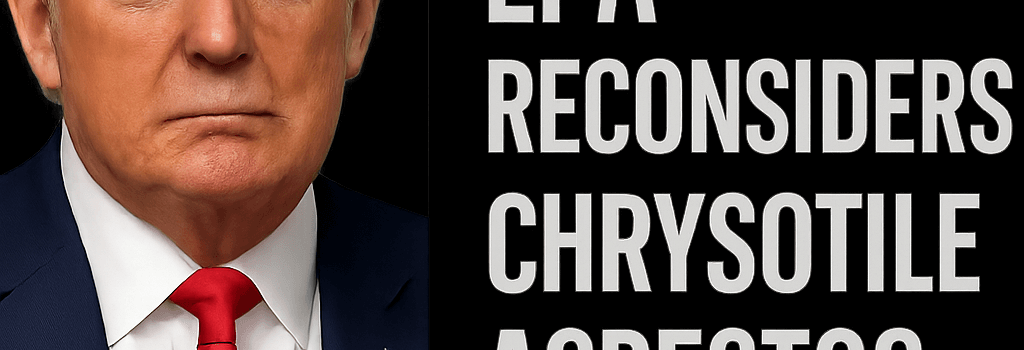Trump’s EPA Reconsiders Chrysotile Asbestos Ban

In June 2025, the Environmental Protection Agency (EPA) under the Trump administration filed court documents indicating it will “reconsider” the late Biden-era ban on chrysotile (white) asbestos. This move reverses a long-awaited public health regulation and reignites debate over the industrial, environmental, and technical dimensions of asbestos use in the United States.
Overview of the Chrysotile Asbestos Ban
Under the Toxic Substances Control Act (TSCA), the EPA in July 2024 finalized a rule banning all ongoing uses of chrysotile asbestos—long associated with mesothelioma, lung cancer, ovarian cancer, and laryngeal cancer. The rule targeted applications in gaskets, brake blocks and linings, aftermarket automotive friction products, and certain diaphragms for chlorine and sodium hydroxide production. With an estimated 40,000 deaths per year in the U.S. linked to asbestos exposure, the ban aligned the U.S. with more than 50 countries that prohibit chrysotile.
Chemical Properties and Hazard Classification
Chrysotile belongs to the serpentine group of fibrous silicate minerals. Its fiber dimensions (length/diameter ratio >3:1) facilitate deep alveolar penetration. The EPA’s Integrated Risk Information System (IRIS) classifies asbestos as a Group A—known human carcinogen—based on dose–response data showing elevated risks at airborne concentrations as low as 0.1 fibers/cm³ over an 8-hour time-weighted average (TWA). The NIOSH Recommended Exposure Limit (REL) mirrors this threshold, while OSHA’s Permissible Exposure Limit (PEL) also remains at 0.1 f/cm³.
Regulatory Framework and Legal Proceedings
- TSCA Section 6 Rulemaking: Initiated in 2016, culminating in the 2024 ban.
- Litigation by Industry: The American Chemistry Council and trade groups challenged the rule in D.C. Circuit Court.
- EPA Reconsideration: The new filing requests a 30-month timeline for review, effectively staying the lawsuit.
“I believe that the movement against asbestos was led by the mob, because it was often mob-related companies that would do the asbestos removal,”
—Donald Trump, The Art of the Comeback (1997)
Global Supply Chain and Industry Perspectives
Russia remains the world’s largest chrysotile exporter, accounting for nearly 60% of global output. In 2018, a Russian mining conglomerate even marketed “Trump-endorsed” asbestos with a presidential seal. U.S. imports historically derive 30–40% from Russia, with smaller volumes from Brazil, China, and Kazakhstan. Reversing the ban could revive domestic demand, impact cross-border tariffs, and influence emerging carbon-fiber and glass-fiber substitute markets.
Advanced Alternatives and Technological Implications
Automotive OEMs and aftermarket suppliers have accelerated R&D on non-asbestos friction materials. Silicon carbide, aramid fibers (e.g., Kevlar®), and phenolic composites now achieve comparable coefficients of friction (0.35–0.45 µ) and wear rates. Likewise, diaphragm cell constructors are transitioning to perfluoroalkoxy (PFA) membranes, which eliminate fibrous particulates but require stringent quality control to prevent pinholes at < 50 nm.
Expert Opinions and Risk Modeling
- Dr. Elena Malinov, Industrial Hygienist: “Even trace chrysotile at 0.01 f/cm³ poses long-term carcinogenic risk when modeled over a 40-year occupational exposure.”
- Prof. Raj Patel, Toxicologist: “The dose-response curve remains linear with no safe threshold for genotoxic fibers like asbestos.”
- Michael Regan, former EPA Administrator: “The science is clear—asbestos is a known carcinogen that has severe impacts on public health.”
Implications and Next Steps
The EPA’s decision to pause litigation and undertake a formal reconsideration introduces procedural complexities under the Administrative Procedure Act (APA). Public comments, Office of Management and Budget (OMB) review, and potential interagency dialogues will extend through late 2027. Stakeholders—including labor unions, environmental NGOs, and industry coalitions—will weigh in via written submissions and potential public hearings.